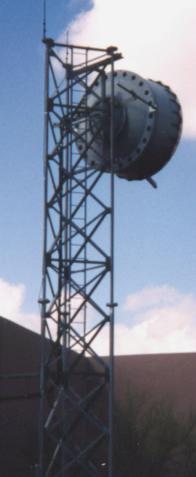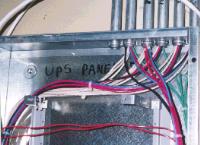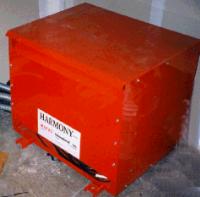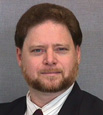- Better Grounding Electrode/Lightning Protection System Needed
- Upgraded Electrical System Addresses Power Quality Problems
- Copper to the Rescue
- No Interruptions
- Finally, a High-Quality Ground
- Thinking Beyond the Code
- Safety First

One such center, located in the southwest, provides international operator-assistance services to a global customer base; operators at the center are the men and women we reach when we ask for overseas directory assistance. It's a large operation: 68 miles of Category 5 copper telecommunications cable were needed to connect the center's more than 600 operator stations, each of which is equipped with one or more computer terminals. The building clearly has a dense concentration of what the IEEE Std. 1100 (The Emerald Book) refers to as "sensitive electronic equipment."
First Data Teleservices must keep the center on-line without interruption, 24 hours a day, seven days a week. Even brief breakdowns, whether they arise from external power interruptions or in-house power quality problems, can disrupt service to thousands of customers. And, because unintentional disconnects of any kind represent lost revenue, outages can quickly become very expensive. The center's electrical system therefore contains "belts-and-suspenders" measures to maximize reliability and power quality, and not surprisingly, those measures rely on copper.
Short-term interruptions are avoided by feeding utility-grid power through a rectifier/inverter-type uninterruptible power supply (UPS). The UPS's battery plant backs up the center's computer equipment and essential services, while a separate battery plant maintains service to the center's 48-VDC telephone system. To guard against longer outages, the UPS itself is backed up by a diesel-driven emergency generator (M-G set).
Equally important is good power quality. Voltage spikes and other transients can disrupt communications and cause data errors. Large surges can damage sensitive electronic equipment. Harmonic distortion is also potentially harmful, and Teleservices is well aware that the center's hundreds of computers and monitors, plus control equipment, electronic lighting ballast's and the UPS itself are fertile harmonic generators.
Better Grounding Electrode/Lightning Protection System Needed
Lightning poses a serious threat to the center's main communications link, a 50-ft microwave tower located near the facility. To prevent lightning strikes from side-flashing into the building, the tower was initially grounded by a series of 10-ft grounding electrodes arranged in a star-shaped pattern surrounding its base. As required by code, the grounding electrodes were also connected to the building's electrical system and equipment grounding circuits through a network of copper conductors tied to ground plates located throughout the plant.
Despite these precautions, there were problems with the grounding electrode system. Ground resistivity in the dry Southwest environment tends to be high, and the approximately 100 ohms resistance to earth measured on the grounding electrode systems was far too high for the center's computer-based communications equipment. High ground resistance was also partly to blame for the computer problems and data transmission errors the center was experiencing.
In an attempt to reduce ground resistance, several more 10-ft ground rods were driven near the tower, and all electrodes were continuously irrigated in the hope that the added moisture would lower the soil's resistivity. Neither fix worked. In fact, ground resistance actually rose to 127 ohms over a period of several years. Back to Top
Upgraded Electrical System Addresses Power Quality Problems
Growing business volume led to a decision to upgrade the center's electrical system, including installation of a larger UPS. At the same time, Teleservices decided to address the grounding electrode system one more time and address some irritating power quality problems that had begun to threaten reliability: little things, like computer keypads that had started to malfunction, creating data-entry errors. A number of the center's computers also began to show symptoms of degrading power quality. Symptoms like malfunctioning keypads and a pattern of increasing data transmission errors can often be traced to an inadequate or high-resistance grounding circuit or to excessive line voltage distortion.
The job of redesigning Teleservices' system was assigned to Computer Power & Consulting Corporation (CPC), Omaha, Nebraska, a nationally recognized problem-solver when it comes to protecting sensitive electronic equipment.
CPC's first order of business was to reduce harmonic distortion in feeder circuits. That step would eliminate one possible source of the center's data transmission errors. Next, they were to improve the center's lightning protection/grounding system, which, by providing the center's computers with a stable and low ground reference potential, should put an end to power quality-related problems. Finally, CPC was to plan and oversee replacement of the center's UPS system.
 Branch circuit wiring at one of two panels served by the harmonic-canceling transformer. NOTE: individual neutrals (white insulation) and separate ground conductors (green) for each circuit
Branch circuit wiring at one of two panels served by the harmonic-canceling transformer. NOTE: individual neutrals (white insulation) and separate ground conductors (green) for each circuitWhile that part of the existing system was acceptable, the original circuits between the UPS and the subpanels serving computer-loaded branch circuits used common neutrals and ground conductors. This was a less-than-optimum arrangement in view of the dense collection of nonlinear loads located downstream.
Back to TopCopper to the Rescue
 Harmonic-canceling isolation transformer. The unit reduces THD by more than 90%, effectively isolating harmonic-rich currents in the secondaries from the building's electrical system.
Harmonic-canceling isolation transformer. The unit reduces THD by more than 90%, effectively isolating harmonic-rich currents in the secondaries from the building's electrical system.CPC specified 100% copper-wound transformers supplied by MIRUS™ International, North York, Ontario. The transformers reduced the 120% THD in the secondaries to a tolerable 12% THD in the primaries. Teleservices accepted CPC's recommendation to install the transformers. One of several units is pictured at left.
Teleservices adopted a number of other CPC recommendations, many of which exceeded Code requirements:
- Limit the number of outlets on branch circuits serving computer equipment to five or fewer. The NEC permits as many as 13 outlets on these 20-A circuits.
- Use #10 AWG copper for branch circuit wiring. The smaller #12 AWG would satisfy Code requirements, but might not accommodate high peak currents. As a bonus, upsizing the branch circuit wiring reduces I2R losses, thereby saving on daily energy costs.
- Pull a separate copper equipment-grounding conductor (green wire) in each branch circuit and bond all such conductors to a ground bar in the panel.
- Use 200% (oversized) neutrals for each transformer secondary. The NEC calls for #6 AWG copper for the 60 A-rated secondaries, but neither the Code nor ANSI/IEEE 1100 provides conductor ratings based on peak currents (See "Telltale Signs of Poor Power Quality"). In this case, the secondaries were upsized to #4 AWG.
Telltale Signs of Poor Power Quality
While it's best to search for the power distortions with appropriate test equipment, distortions caused by harmonics are often detectable using a few simple checks:
- High harmonic contents in branch circuits can be detected at isolation transformer secondaries (or at branch circuit panels). in the communications center described in the article, measurements, taken while the center was operating at moderate (but less than peak) load showed phase currents of 43 A, 45A and 37A, respectively, but the neutral current was nearly 73 A! The large return current resulted from harmonic distortion generated by numerous nonlinear loads (in this case, computers and monitors) in the branch circuits.
- Crest factors are another tip-off to the presence of harmonics, but standard voltage measurements don't always reveal them. For example, typical computer-loaded branch circuit voltages at the Teleservices center indicated 119 Vrms/165 V peak during moderate loading. At face value, that appeared quite normal. However, the branch circuit currents measured 7 A rms/21 A peak because computer loads are highly nonlinear (current not proportional to voltage). The peak current was more than twice what it would be if only linear loads were present.
- Crest factors between 2.5 and 3.5 can be expected in circuits containing large concentrations of computer equipment. This is not unusual. Under these conditions, a 20-A #12 branch circuit carrying 15 A rms current can experience peak currents of 35-50 A! The result: voltage drop and high neutral-ground voltages. At Teleservices' isolation transformer secondaries, typical rms and peak currents (in one phase) measured 43.0 A and 96.4 A, respectively. The crest factor, 2.24 was nearly 60% higher than what it would have been for a purely linear load. While these simple tests may provide a telltale sign of harmonic distortion, it is recommended to use "true rms" test instruments when making power quality measurements.
- High neutral-to-ground potentials are another sign of lurking power quality problems. At Teleservices center, neutrals and grounds were bonded at the UPS output transformer, as they should have been. Neutral-to-ground potentials at outlets located 100ft farther away were exceeding the 2-Vrms limit recommended by electronic equipment suppliers.
No Interruptions
Teleservices followed CPC's recommendations and upgraded their electrical system with additional copper neutral and ground conductors. A photograph of a rewired branch circuit panel can be seen above. Note that each branch circuit is now equipped with a separate full-size neutral conductor (white wire) as well as a separate full-size grounding conductor (green wire). These additional wires, respectively, avoid overheating of the neutral conductor and ensure that each circuit is properly grounded according to recommended practices.
Installing the new UPS turned out to be CPC's trickiest challenge. The change-out had to be completely transparent to the center's operation. "Teleservices' orders to us were simple," said CPC's Martin Conroy. "Get the job done with minimum impact to service. Period."
 One of several ground plates installed at the teleservices communications center. Plates are mounted on standoffs to allow reliable bolt-through connections
One of several ground plates installed at the teleservices communications center. Plates are mounted on standoffs to allow reliable bolt-through connectionsThe plan devised by CPC and Teleservices' technical support director Dan Marron called for placing the center on emergency power using the diesel-driven M-G set during replacement of the UPS system. The UPS could then be safely bypassed, since there would still be redundancy (grid power and the M-G set) in the system. The plan could not have worked without the harmonic treatment transformers because the M-G set's synching circuits had to remain shielded from the distorted waveforms emanating from the computer branch circuits
"From a safety standpoint, we could have downrated standard transformers or installed K-rated units instead of using isolation transformers," said Teleservices' Marron. "Both options would have handled the high neutral currents. But the harmonic-canceling feature of the isolation transformers protected upstream system components. That was especially important when we changed out the UPS."
Back to TopFinally, a High-Quality Ground
CPC also specified—and Teleservices installed—a new grounding electrode system, adding one 90-ft-deep copper-clad grounding electrode to the existing 10-ft ground rods. The entire network was bonded to a grounding plate in the building's main electrical room using 300-kcmil copper cable.
Resistance of the new grounding electrode system, which is no longer irrigated, has remained stable at 2.7 ohms for several years. All exothermic-welded connections to electrodes and grounding electrode conductors have remained sound and corrosion-free. Thanks to copper, the communications center finally has a dependable, high-quality, low-resistance ground connection.
And the grounding system now works as it should. Keypads have stopped malfunctioning, workstation computers operate normally again and data errors have dropped to zero.There have been no interruptions due to poor power quality since the new low-resistance, copper-based grounding system was installed.
"I wasn't surprised," said CPC's Conroy. "One of the ways we ensure reliability is by specifying heavy-gauge copper grounding conductors. We called for 300-kcmil copper in the Teleservices installation, but we sometimes specify grounding conductors as heavy as 500 kcmil even though the NEC permits much smaller sizes. The conductor represents a tiny fraction of the grounding system's cost, and it is definitely not the place to save a few dollars when you consider what's at stake. We insist on copper to make sure the connections will remain sound over the life of the system."
Back to TopThinking Beyond the Code
Installations like Teleservices' voice services center must be as fail-safe as possible. Maximum reliability is assured by an intelligently designed and correctly installed electrical system, one that is based on the nature of the loads involved. It is absolutely essential that nonlinear loads be taken into account during system design.
What are the common nonlinear loads? Besides computers, monitors and UPS units, they include such equipment as variable frequency drives, x-ray and other diagnostic equipment, arc welding power supplies, electronic fluorescent lighting ballasts and any devices that utilize switched-mode power supplies.
What can be done about poor power quality? Plenty, beginning with thinking beyond the NEC. The Code's purpose is to ensure safety. It has only recently begun to address power quality issues. To avoid power quality problems, the recommended practices published in IEEE 1100 (The Emerald Book) and IEEE 142 (The Green Book) are good starting points. Other worthwhile recommendations can be found in TIA/EIA 607. The recommendations aren't complicated, and they make sense.
Based on those sources, along with proven field experiences like that with First Data Teleservices, the following guidelines should pay off in more ways than one:
- Install no more than four to six outlets per branch circuit in those branch circuits that serve computers and other sensitive electronic equipment. Segregate outlets that serve computer equipment from those used for general service. (Separate panelboards and feeders are also recommended.)
- Use oversized conductors to account for peak loads, since these loads may be up to three times that of rms current levels when power is severely distorted. This smart practice also reduces energy (I2R) losses. (See table 1 below for an example.)
- Specify oversized neutrals in three-phase circuits feeding nonlinear-load branch circuits. Better still, use separate full-sized neutrals for each phase leg.
- Don't rely on conduit or raceways as equipment-grounding conductors, Instead, include a separate copper grounding conductor (green wire) for each circuit. Follow recommendations spelled out in IEEE 1100 and TIA/EIA 607. Above all, make sure all systems are properly bonded to a common grounding electrode system.
- Verify that the grounding electrode system indicates a resistance no greater than 10 ohms, less in installations that contain computers and other sensitive electronic equipment. (Most computer equipment manufacturers now recommend 2 ohms maximum ground resistance.) Install a heavy-gauge copper ring ground and multiple vertical grounding electrodes wherever practical.
- Use only copper grounding electrode conductors, preferably 250 kcmil or larger, and copper or copper-alloy connectors. Copper resists corrosion, and copper connectors remain tight.
- Specify copper-wound harmonic-canceling isolation transformers between nonlinear loads and upstream circuits, or depending on your engineer's advice, call for shielded isolation transformers. If standard transformers are acceptable, specify copper-wound K-rated transformers to accommodate high neutral currents.
These recommendations may increase the initial cost of a system a few percent, but they will reap tremendous reliability rewards. Life-cycle costs should decrease as a result of lower maintenance, repair and downtime costs.
Back to TopSafety First
And, of course, in no case do these recommendations mean that one should violate the NEC. However, it is important to understand that the NEC primarily addresses safety, not performance. Safety always remains the governing issue in system design, but it is no longer the only consideration. Today's sensitive electronic equipment demands high power quality. Good system design, as exemplified at Teleservices Corporation, is the best first step toward meeting that demand.
Back to TopThe Principals
Atlanta-based First Data Corporation is a global leader in payment systems, electronic commerce and information management products and services. First Data and its principal operating units process the information that allows millions of consumers to pay for goods and services by credit, debit or stored card at the point of sale or over the Internet, or by check or wired money. With an international employee base of more than 33,000, First Data delivers innovative solutions and quality service to a broad base of clients and consumers.
First Data Teleservices is a leading provider of voice center services to the telecommunications and financial-services industries. The company operates voice-operations centers throughout the USA.
 Dan Marron is Teleservices' director of technical support. Based at Teleservices' Omaha headquarters, Dan oversees the technical operation and maintenance of his company's telecommunications centers.
Dan Marron is Teleservices' director of technical support. Based at Teleservices' Omaha headquarters, Dan oversees the technical operation and maintenance of his company's telecommunications centers. Martin Conroy is president of Computer Power and Consulting Corporation, Omaha, Nebraska. For the past 18 years, CPC has specialized in the field of power quality consulting and technical services, diagnosis and remediation, as well as seminars and technical papers. He is a Nebraska Class A Electrical Contractor and an IAEI-certified Electrical Inspector. CPC operates throughout the USA. The company can be reached at 402-571-2322 or on the Web at www.cpccorp.com.
Martin Conroy is president of Computer Power and Consulting Corporation, Omaha, Nebraska. For the past 18 years, CPC has specialized in the field of power quality consulting and technical services, diagnosis and remediation, as well as seminars and technical papers. He is a Nebraska Class A Electrical Contractor and an IAEI-certified Electrical Inspector. CPC operates throughout the USA. The company can be reached at 402-571-2322 or on the Web at www.cpccorp.com.
